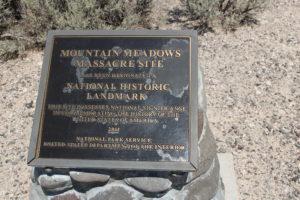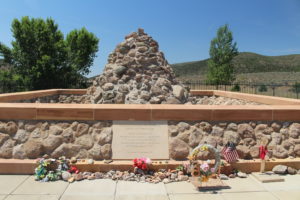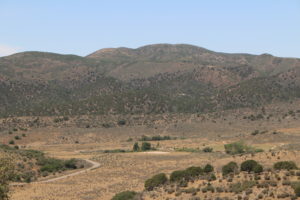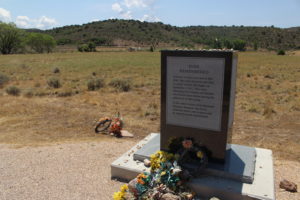 On September 11, 1857, 120 unarmed members of a wagon train traveling from Arkansas to California were slaughtered by members of the Mormon Militia in Iron County, Utah. Known as the Mountain Meadows Massacre, the event was first covered up, then denied by the Mormons. Once the facts of the event became known, the leader of the militia, John D. Lee, was tried and shot by the United States government. He was the only member of the Mormon Militia ever convicted of the crime.
On September 11, 1857, 120 unarmed members of a wagon train traveling from Arkansas to California were slaughtered by members of the Mormon Militia in Iron County, Utah. Known as the Mountain Meadows Massacre, the event was first covered up, then denied by the Mormons. Once the facts of the event became known, the leader of the militia, John D. Lee, was tried and shot by the United States government. He was the only member of the Mormon Militia ever convicted of the crime.
What could make a group of Mormon pioneers ruthlessly slaughter men, women, and children of a peaceful wagon train? The story is one of the darker stories in American history and may be a teaching moment for our “us vs them” society.
In 1847 the Latter Day Saints, under the leadership of Brigham Young, left the United States and moved to the Utah wilderness in Mexico. They left because they had been repeatedly persecuted wherever they tried to live. The Mormon pioneers made their way in this wilderness and created a place to live in the desert. But just a year later, the United States acquired Utah territory from Mexico and the Mormons were back in the United States.
Because of their previous persecution, the Latter Day Saints formed groups of militia to protect the Mormons in case of attack by the United States Army. President James Buchanan, fearing the theocracy established by Brigham Young, ordered troops to Utah in 1857 to establish a territorial governor other than Young. Rumors flew over the Mormon frontier. The troops were going to take Brigham Young to prison. The troops would murder the men and rape the women. Settlers from back East were following the troops in order to steal the homesteads the Latter Day Saints pioneers had worked so hard to build.
Brigham Young ordered the militia to patrol their areas. He also told the LDS people not to aid any wagon trains coming into the area. Wagon trains coming into Salt Lake City were not allowed to buy anything in the stores. One Mormon family that gave water to a wagon train was killed by the Mormon militia for aiding and abetting. To say the Mormon pioneers were paranoid would be an understatement.
The unsuspecting Baker-Fancher wagon train came into this atmosphere without knowing what to expect. The wagon train came from Arkansas and was a particularly large and wealthy group. There were 140 people in the party. They were refused supplies in Salt Lake City and decided to continue to California via the Old Spanish Trail. When the wagon train reach Mountain Meadow on September 7, they were attacked by the Mormon Militia and a small number of Paiutes recruited by the Mormons.
Seven members of the wagon train were killed and 16 were wounded. But the people in the Baker-Fancher party stayed controlled and disciplined and did not surrender. The Paiutes had been promised that the battle would be short and glorious, and they left after the first day. The Mormon Militia kept the wagon train besieged for four days. Finally, out of water and ammunition, the members of the wagon train asked for terms for surrender. John D. Lee, the leader of the Mormon Militia, promised them safe passage if they would give up their cattle and their guns. Reluctantly the Baker-Fancher party laid down their weapons and surrendered.
On September 11 all the surviving members of the wagon train were led about a mile away from their wagons. At a signal from John D. Lee the members of the militia killed all the men. Then they trained their guns on the women and children. All the members of the Baker-Fancher party older than three were killed. The surviving children were adopted into the families of the men who had killed their parents.
Members of the militia were sworn to secrecy. They decided to blame the southern Paiutes for the Mountain Meadows Massacre. The belongings of the wagon train were divided up between the leaders of the militia. Some of the cattle went to the Paiutes but most went to John D. Lee. Brigham Young sent a report to the US Army stating that the emigrants were killed by Native Americans.
In 1859, the US Army decided to conduct their own investigation. Major James Carleton found the remains of the victims scattered throughout Mountain Meadow. He found bones of women still clasping their children in their arms. He buried the bones and interviewed Mormons and Paiutes in the area. After determining that the Mormon Militia instigated the attack, the US government indicted the nine leaders of the militia. These leaders went into hiding and there wasn’t a trial until 1870. Only John D Lee was convicted. He was executed while sitting on top of his coffin on March 23, 1877. Before he died he stated that he was a scapegoat for all the participants in the massacre and for the Mormon church.
Tom and I visited the Mountain Meadows Massacre Memorial a few weeks ago. There are four parts to the memorial. The men’s memorial, where the men were shot. The women’s memorial where the women and children were killed. An overlook memorial that allows you to see the three memorials. And the main memorial where the first attack occurred.
We were especially moved by the main Mountain Meadows Massacre Memorial. Gravestones surround a stone column and cross. I walked around the memorial and read each gravestone. It was very powerful to see the names of all the family members and their ages inscribed. The United States flag and the flag of the state of Arkansas fly over the monument. Today it is maintained by the state of Utah and the Church of Jesus Christ of Latter Day Saints.
Seeing a memorial for a massacre is never easy. But it was important to us, as we interpret a monument to the LDS pioneers, to visit the Mountain Meadows Massacre Memorial. It reminded us of what distrust and division can do. And it also gave us hope that we can find a way through our divisions to unity as a country.





One comment